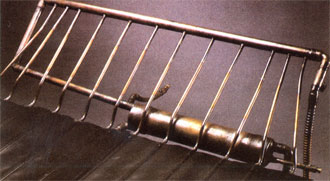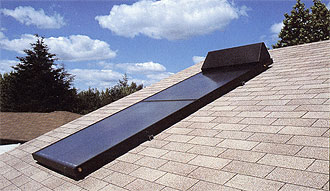Copper Critical Element in Long-Lived Solar Heater
"Copper was the only material we could trust to last at least 50 years in our solar water heater." This is how Bob Block, president, Sage Advance Corporation, endorsed the selection of the high-heat-transmission, corrosion-resistant metal for the critical elements in his company's "Copper Cricket."
The Cricket is unique among solar water heaters. It doesn't require any pumps, valves, controls or other moving parts or electric power to function. How can the Cricket operate without the costly complications of competing systems?
 The array of copper collector tubes inside the Cricket.
The array of copper collector tubes inside the Cricket."It functions like a coffee percolator," said Dr. Eldon Haines, the physicist who invented and patented it. Bubbles generated in the 15 percent methanol 85 percent water solution inside the copper collector tubes push the solution up to the header pipe at the top of the roof-mounted unit. Because the sealed system operates under vacuum, the solution inside only has to be heated to 65 F by the sun's rays to start bubbling.
The bubbling solution gathering in the header pipe generates enough head (pumping pressure) to be pushed down to a heat exchanger located underneath the user's existing water tank. There solar heat is trans ferred to the water in the tank. The now-cold solution is then pushed back up to the array of copper collector tubes by the down-flowing hot solution.
The all-copper heat exchanger, which can be located as much as 36 feet below the header, is double-walled. This safety precaution is needed because methanol is toxic. Because the methanol/water combination, unlike pure water, shrinks when it freezes, the copper tubing can never be ruptured by freezing. The systems are warranted for 10 years.
Just how much of a user's annual hot-water load can be provided by the Cricket? The contribution ranges from a substantial 91 percent in sunny Phoenix, Arizona, to a beneficial 41 percent in cooler Boston. Made in Eugene, Oregon, the Cricket is cost effective even in its often overcast home state.
Investing in a Cricket, which costs $2,180 in kit form, can be especially attractive when a building's water is heated electrically. This is because many power companies are subsidizing installations that reduce peak demand. Why are these capacity-shy utilities paying their customers to use less of their product? Because it costs so much and takes so long to add capacity.
The rebates range from $300 up to a whopping $1,400 in Sacramento, California, whose local power company has been deprived of its nuclear capability. Most Crickets are installed in 16 to 20 person-hours by plumbing or heating contractors. A handy homeowner might require as much as 30 hours to mount the 150-pound Cricket on his roof and then tie it to the hot water heating system.
 The flat, glass-topped Copper Cricket resembles a skylight when mounted on a roof.
The flat, glass-topped Copper Cricket resembles a skylight when mounted on a roof.Most of the 1,200 Crickets installed to date are in service in residences. However, Block noted that they are almost universally applicable because all buildings and businesses need hot water. For instance, Crickets have been installed in car washes.
The largest installation is in a remote campsite in Tonto National Forest in Arizona. Tapping the Sun's energy was a requirement-needed electric power is generated by photo-voltaic cells-because of the prohibitive cost (nearly $800,000) of bringing in power from the nearest substation seven miles away.
All the hot water for the campground's buildings is provided by 30 solar heat collectors, mounted in six clusters, that cost a total of $105,000 to install.
Could any material other than copper have been used in the critical parts of the Cricket? As Block put it, "We investigated other materials rigorously; in terms of heat conductivity, resistance to corrosion, workability, sealability and longevity, we found no substitute for copper."
Also in this Issue:
- Copper Outlasts Gold At Boston’s Old State House
- 3,000 Year-Old Copper/Bronze Statue On Display
- Copper Protects Doors and Windows from Salt Spray
- Copper Critical Element in Long-Lived Solar Heater
- Copper Brightens Homes
- Overcoming Water Shortages With Copper
- Stamp of Approval for Copper
